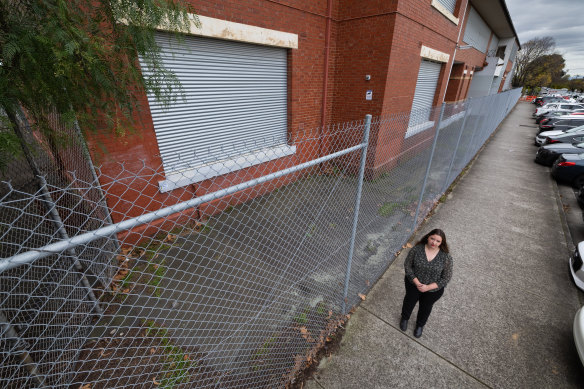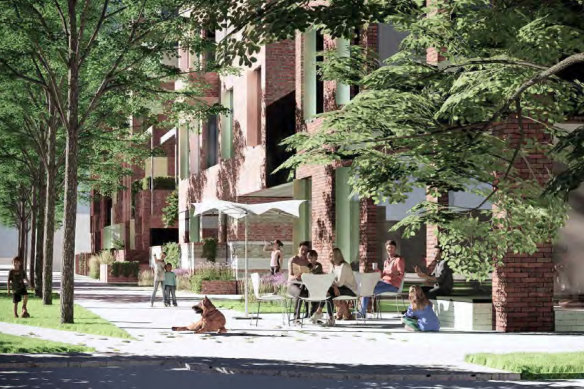By Rachael Dexter
A council in Melbourne’s inner north has lashed the state government over the paltry number of low-cost homes in a major redevelopment of a former TAFE campus.
Four apartment buildings are slated for the 2.2-acre block of state-owned land on The Avenue in Coburg, which has previously been used as a Kangan TAFE campus, a secondary college and more recently by the Level Crossing Removal Authority.

Greens councillor Angelica Panopoulos has described the affordable housing offering at the TAFE site redevelopment as “pathetic”.Credit: Jason South
An eight-storey, a six-storey and two five-storey buildings have been proposed for the site, totalling 274 private rented apartments. The proposal, part of the first wave of housing projects to emerge from Labor’s landmark Housing Statement last September, also includes ground floor cafes and a park across the road.
Merri-bek council commended aspects of the plan such as the architectural, sustainability and disability credentials, and the new park. However, it has taken issue with the small amount of affordable housing offered – 10 per cent (about 27 of the 274 apartments) for moderate income earners, with a likely commitment to a 10-year period.
Moderate income earners are defined by the Planning Act as single adults earning between $47,631 and $71,450 a year, a couple with no children earning a combined $71,451 to $107,170, or a family earning $100,031 to $150,030.
Council planning officers said the need in Coburg was for low and very low-income households, and that what the state government was offering as affordable housing was no different to what was already being provided by the private market.
“For the offer to be a real and genuine affordable housing offer, and to be of real and genuine community benefit, it would need to address the needs of low and very low-income households (ideally at least 5 per cent), [and] extend for a longer duration (at least 20 years),” the council officers’ recommendations read.
A low-income person in Melbourne is defined by the state government as someone earning between $29,771 and $47,630 a year, while a very low-income person is defined as someone earning up to $29,770.
Last year, The Age reported that the government’s parameters for affordable rentals left many workers, such as cleaners and baristas, and childcare and aged care staff, priced out of Melbourne’s inner and middle suburbs.
Merri-bek council has asked for the percentage of the affordable housing in the Coburg development to be increased to 20 per cent, with half allocated for people on the public housing waiting list.

An artist’s impression of the proposed redevelopment of a former TAFE campus in Coburg.Credit: Development Victoria
It also requested that two levels be removed from one building and one level from another, and that space is allocated for “employment uses”.
The council’s response to the proposal also included a statement by Greens councillor Angelica Panopoulos lamenting that the site wasn’t being wholly used for public housing.
Panopoulos said the offer of majority private housing was “fine, but not when you’ve got state government-owned land”.
“It’s pretty pathetic, to be honest,” she said. “It’s a huge piece of land – a big opportunity to help out the most vulnerable in our community.”
At Merri-bek’s latest planning meeting, Development Victoria’s chief development officer, Joanne Wandel, told councillors the development would deliver “a diverse range of accessible, affordable and high-quality housing for different budgets, lifestyles and people”.
When asked by independent councillor James Conlan why public housing was not considered for the site, Wandel said she could not speak to “government considerations and decisions”.
A spokeswoman for Housing Minister Harriet Shing referred questions to Development Victoria.
After publication, Development Victoria responded with a statement from acting chief development officer Hannah Clement, which said: “The project is currently going through the planning application process which will include opportunities for the community and council to provide feedback.”
The body did not respond to a number of specific questions about the amount and type of affordable housing and tenure, the decision not to include public or community housing or whether the state would retain the rental homes as landlord.
Planning Minister Sonya Kilkenny’s office, which also responded after publication and also did not answer specific questions about the development, said only that “any proposal will be considered on its merits”
“Our nation-leading $5.3bn Big Housing Build is delivering 12,000 new social homes, with 9400 completed or underway since 2020 and more than 4000 households either moved in or getting ready to move into their new homes,” the statement read.
Start the day with a summary of the day’s most important and interesting stories, analysis and insights. Sign up for our Morning Edition newsletter.